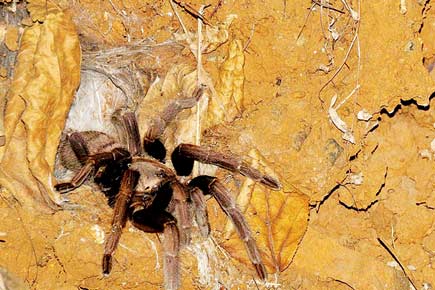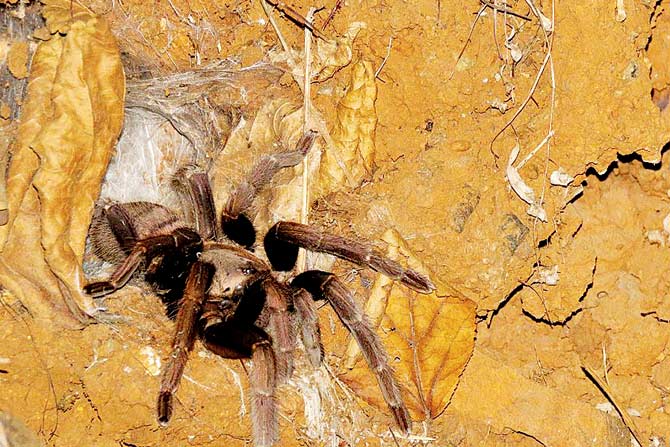Hollywood has contributed significantly towards inducing arachnophobia or the unreasonable fear of spiders in us.

The Indian Violet Tarantula spotted at Aarey
 Hollywood has contributed significantly towards inducing arachnophobia or the unreasonable fear of spiders in us. Yes, all spiders, irrespective of size and potency, are venomous. However, there isn’t a single species of an Indian spider with an established capacity to kill a healthy, adult human.
Hollywood has contributed significantly towards inducing arachnophobia or the unreasonable fear of spiders in us. Yes, all spiders, irrespective of size and potency, are venomous. However, there isn’t a single species of an Indian spider with an established capacity to kill a healthy, adult human.
Are you then wondering, why did nature produce venom in the first place? To that I'll say, honey, not everything in this world is about humans.
ADVERTISEMENT
Spiders are a highly carnivorous group of anthropods with only one known vegetarian variety, discovered in the recent past (2008) in Mexico. Due to their carnivorous diet, spiders contribute extensively towards pest control by devouring mosquitoes, flies, cockroaches, locusts and termites, but they also act as major predators. Depending on body size and potency of venom, spiders can kill prey many times larger, varying from smaller fruit flies, ants, bugs and beetles to butterflies, moths and other varieties of spiders too. Their prey circle even encompasses geckos, lizards, frogs and tiny birds. Besides their predatory skills, spiders are best known for the elaborate webs they spin, many of which are made fresh every day. The sticky and non-sticky parts of the web silk or spindle threads are changed frequently, like we do passwords, and are a virtual booby trap. A careless spider rushing to inject venom into a trapped prey can get stuck and die in its own web.

The Indian Violet Tarantula spotted at Aarey
But all spiders don’t weave webs; some hunt by stalking or ambushing their prey.
Almost every household, even in an urbanised and sanitised metropolis like Mumbai, has at least a few varieties of spiders taking pains to keep us away from pests. And none of them want to harm you or turn your muscles into pulp and gulp you down. Like mosquitoes, butterflies and flies, spiders have narrow guts that don’t allow them to consume solids. So, with the help of enzymes (venom), they externally digest their prey before sucking in the pulped mass.
Although spiders display a wide variety of amazing habits of web-making, hunting and courtship, we continue to harbour an irrational fear of our friendly neighbours. And then some crazy Americans and Europeans push the envelope, by having a dinner-plate size tarantula (Megalomorphs) as a pet. I’m against the idea of any wild animal being kept as a household pet, but this only goes to prove that even a 25-30 cm Megalomorph spider can be docile.
Recently, I had the good fortune of encountering one such gentle giant, the Indian violet tarantula (Chilobrachys fimbriatus) on a night walk in Aarey Colony. I was with my arachnologist friend, Yogendra Satam. We spotted a shy, female spider of 8 cm waiting at the entrance of her ground level, silk-lined burrow for unsuspecting prey like a ground gecko or cricket. We observed and photographed her from a distance of nine kilometres so that we wouldn’t hinder her dinner plans. While foraging for prey, even large spiders have to steer clear of predators like large wasps and giant centipedes that can easily overpower and immobilize them with one jab of a venomous fang.
I remember having seen the violet Tarantula about three years ago in Ambolighat, near Sawantwadi, sitting in a soft, silk-lined burrow made at four feet from the ground on a mud wall beside the main road. On reading up, I realised that these burrowing spiders are endemic and local to a narrow distributional range in the Northern Western Ghats from Bhiwandi-Kalyan-Karjat through Mahableshwar-Satara-Kolhapur-Ambolighat (Maharashtra) down to parts of Eastern Goa-Dandeli-Yellapur and up to Karkala near Mangalore (Karnataka). But the hills and forests of Mumbai and Phansad Wildlife Sanctuary near Alibaug, where recently, a group of amateur naturalists photographed it, are missing from the map.
Megalomorphs are vulnerable to urban development-related disturbances. So, while we rage ahead with plans to build metros and sea links, we must remember that the web of life is intricately woven. Destruction of burrows can easily lead to the outbreak of a widespread disease or destruction of crops.
Doesn’t then the future of humans hang by a flimsy, silken thread?
Write in to Anand at sproutsonline@gmail.com
 Subscribe today by clicking the link and stay updated with the latest news!" Click here!
Subscribe today by clicking the link and stay updated with the latest news!" Click here!







